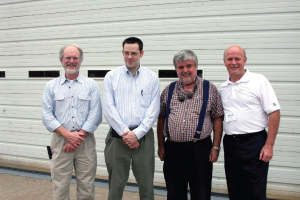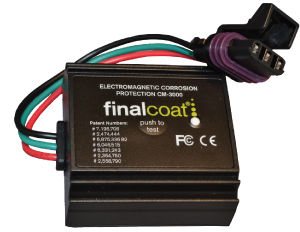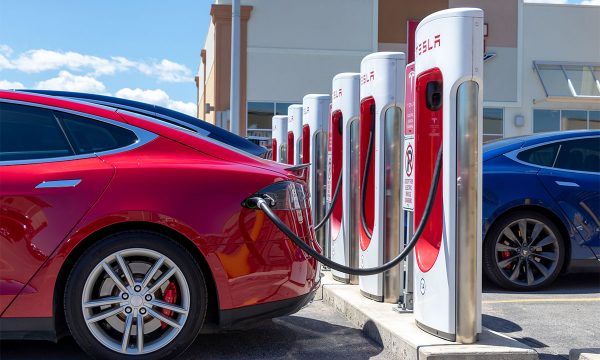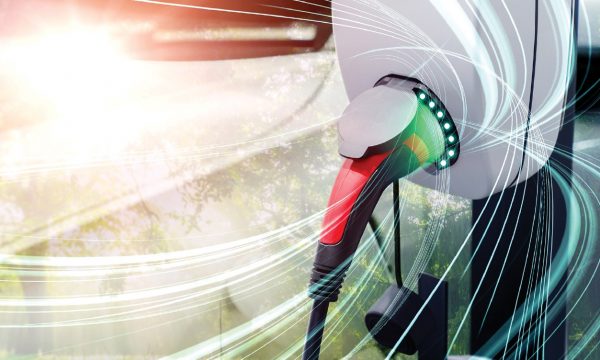Canadian auto dealer is invited to an Ohio lab to get the lowdown on an electro-magnetic rust control product
Given Canada’s harsh climate and the substantial investment consumers make in new vehicles, the notion of protecting them against the elements is a big one, which for dealers, means that corrosion protection is often a contentious issue for their customers. Canadian Auto Preservation Inc., via its FinalCoat line offers a corrosion system for F&I departments, one that it says is backed by solid research.

From left to right, Dr. Michael Lewis; electro-chemist, Jason Lafferty; Dr. Digby MacDonald and CAP CEO Randy Peek at CAP’s Research and Development Laboratories in Hartville, Ohio.
When CAP CEO Randy Peek first heard about an electro-magnetic rust control process discovered by Dr. Michael Lewis, he wasn’t convinced. Peek, who’d opened his own business specializing in automotive rust proofing and paint protection products in 1983, was visiting a trade show in the mid-1990s when he first came across Lewis’s idea.
“Using a process where an electro-magnetic wave induces alternating current that activates zinc to create electrons on galvanized (zinc coated) steel panels, Lewis’s theory was that it would provide a barrier to oxidization over the entire area of the panel,” says Peek. “As a result, on a vehicle, it would theoretically enable protection of the entire surface, including corrosion induced by stone chips.”
To Peek, it seemed almost too good to be true. “Especially when I couldn’t see any actual test results,” he says. Nevertheless, when he heard about it again, Peek decided to get Royal & Sun Alliance involved to underwrite it, to see if there truly was market potential for this new technology.
TOO GOOD TO BE TRUE?
Peek, whose company had built its business supplying vehicle protection products to dealers, figured that if there was a way in which Lewis’s discovery could be supported by solid scientific evidence, it might just revolutionize the concept of vehicle corrosion protection sold through dealers.
He decided to team up with Lewis and set up a lab in Hartville, near Akron, Ohio to conduct further tests. Although Peek knew that previous attempts at electronic rust control, using a direct current (DC) cathodic charge had been analyzed by the Competition Bureau of Canada and were discovered to be ineffective on vehicles (only providing a barrier to corrosion when in immersed in salt water, such as ship hulls and submarines), it seemed that Lewis and his lab team were onto something.
 TAKING A GAMBLE
TAKING A GAMBLE
Peek agreed to purchase the technology and began readying it for market in Canada in 1997. With warranty coverage underwritten by Royal & Sun Alliance which covered either 10 years with no annual inspection, or vehicle life with an annual check up, the new FinalCoat CM Modules, designed to inhibit corrosion over the entire surface of a new or pre-owned vehicle, appeared to be an asset for dealers, proving more attractive than messy chemical sprays.
Although the upfront cost was significantly more than an annual spray for dealer customers, with a warranty covering a 10 year period and the unit transferable from vehicle to vehicle, the idea was, that longer term, the module would work out to be more cost effective for the consumer.
However, with growing controversy surrounding electronic modules and their effectiveness, CAP and its products soon became a target for the Canada’s federal Competition Bureau, which requested independent tests to back CAP’s claims for the product. “Between 2001 and 2004, we repeatedly had to demonstrate our technology,” Peek said “and the Bureau was determined to prove that it didn’t work.”
Enter Dr. Digby Macdonald, a distinguished professor of Materials Science and Engineering and Director of the Center of Electrochemical Science and Technology at Penn State University, recognized as one of the world’s leading experts on corrosion, specifically electromagnetism and electrochemistry.
“Getting Digby involved was absolutely huge,” says Peek. “He is highly respected in his field and was impressed by what he saw with this technology. His findings and support, plus exhaustive test after test conducted over a two and a half year period, proved that the technology did work.”
Peek says the results found that in the worst scenario the tests delivered a 98 per cent reduction in corrosion, and at best a 99.7 per cent reduction. For the Competition Bureau, the conclusion was that the tests proved to be “adequate and proper.” The CAP Final Coat EICCT (Electromagnetic Induction Corrosion Control Technology) case, proved to be a pivotal one, to such an extent in fact that it is now studied by students of Competition and Regulatory law courses across Canada.
MOVING FORWARD
Since then, CAP has further expanded scientific research into the areas of corrosion, setting up a new lab and introducing new modules and technologies, such as the CM 3000. To show the company’s progress, Canadian auto dealer was flown down to the firm’s research facility in Hartville as part of an exclusive media tour, to learn more about its electromagnetic technology and to meet personally with Michael Lewis and Digby Macdonald.
They explained to us that the key to the module is that when the vehicle paint surface is chipped and the galvanized steel is exposed to the elements, the zinc begins to oxidize, eventually exposing the bare steel and causing it to rust. The module uses an electro-magnetic wave that creates a current that reactivates the zinc, in other words, forming a new barrier against protection in areas where the paint surface is compromised.
“Our newest modules offer the lowest draw yet,” says Peek. “They provide entire surface protection, which is warrantied both outside and in, but uses just one third of a milliamp of power drawn from the vehicle’s battery (when CAP started with its modules, the draw was around 12.6 milliamps),” he says. “Combined with verified scientific test results and ongoing research, they make for a good F&I product which dealers can sell directly to their customers, especially in areas of Canada where salted winter roads tend to accelerate the rusting process on vehicles.”











